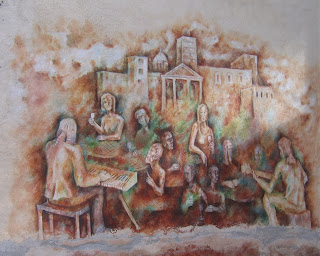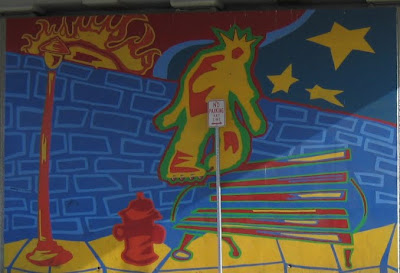I decided to drive around town today and check out our city's street art. Last week when the students made their pastel drawings we talked about how the Lascaux cave paintings tell a story from 17,000 years ago. The brick wall drawings the children did this last week tell a story about what they find to be important parts of their lives and culture. We talked about Boise's street art last week before the children began their work - and many of them came up with the examples I will post below. I was surprised when I returned home that I had so many photos!
Here goes!
This mural sits on the edge of the Basque Block in Boise
A little dinner music?
The Skate Park downtown is loaded with skating imagery.
Action!
Pow!
Ceramica offers a little magic.

Even the electrical units are covered with art!
The coop sends greeting to Ninth Street visitors.

Do you think this might be an ad to remind you to put your bike in the garage at night?

A favorite store in downtown Boise

If dogs could read, they might want to stop in.
A familiar glance at the foothills
Freak Alley offers local street artists a place to practice their skills.
The artists are given an area to show their work.
There is always a variety of artwork on display
And this is a very popular area on the city's public art walk
A nice touch outside of a Boise design agency
A message seen from the connector from people that care.
Part of the city's attention to detail
and more detail.
You' might feel like royalty when you get your auto serviced here.
City lights in Boise
Can you guess where this might be?
Or how about this?
A familiar neighborhood painting adorns the outside of a favorite local market
Celebrating nearly century old touring cars.
But then you can always take a trolley.
Hungry folks might recognize this wall painting
And every parent can identify with this tender touch.
I'll be back with one more to add that I must have accidentally erased. I'll stick it somewhere in the middle and let's see if anyone can find it.
Have a great week!
Amy
























































